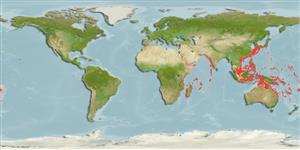Environment: milieu / climate zone / εύρος βάθους / distribution range
Οικολογία
Θαλασσινό(ά); Υφάλμυρο βενθικό(ς); εύρος βάθους 30 - 240 m (Ref. 9824). Temperate
Indo-West Pacific: from Saya de Malha Bank; north to southern Japan, Taiwan, South China Sea to Coral Sea.
Μέγεθος / Βάρος / Age
Γεννητική Ωρίμανση: Lm ? range ? - ? cm
Max length : 16.0 cm SL αρσενικό/απροσδιόριστο; (Ref. 48637)
Μαλακές ραχιαίες ακτίνες (συνολικά) : 88 - 98; Μαλακές εδρικές ακτίνες: 60 - 77; Σπόνδυλοι: 35 - 37. This species is distinguished by the following characters: gill rakers 0-6 + 13-18; anterior margin of head is anterior to both eyes with about 4-5 pale blotches margined by dark bands; compared to.body scales, the scales on front margin of head more strongly ctenoid and are non-deciduous (Ref. 126076).
Description. D 92 (88–98, from other localities), A 65 (60–77), pectoral-fin rays on ocular-side 12 (12–13), on blind-side 9 (10–12), caudal-fin rays 3 + 11 + 3 (3 + 11 + 3), ocular-side pelvic-fin rays 6 (6), blind-side pelvic-fin rays 6 (6), scales in lateral line 40 (39–50), gill rakers 0 + 13 (0–6 + 13–18), vertebrae 10 + 26 (10 + 25–27) (Ref. 126076).
Cross section: flattened.
Inhabits muddy substrates in shallow estuaries and still bays to about 30 meters depth. Active at night and usually burries itself in the sand during the day (Ref. 48637). Feeds on small benthic animals. Rarely caught by bottom trawls.
Life cycle and mating behavior
Γεννητική Ωρίμανση | Αναπαραγωγή | Γεννοβολία | Αβγά | Γονιμότητα | Προνύμφες
Hensley, D.A. and K. Amaoka, 2001. Bothidae. Lefteye flounders. p. 3799-3841. In K.E. Carpenter and V. Niem (eds.) FAO species identification guide for fishery purposes. The living marine resources of the Western Central Pacific. Vol. 6. Bony fishes part 4 (Labridae to Latimeriidae), estuarine crocodiles. FAO, Rome. (Ref. 9824)
IUCN Red List Status (Ref. 130435: Version 2025-1)
Threat to humans
Harmless
Human uses
Εργαλεία
Special reports
Download XML
Διαδικτυακές πηγές
Estimates based on models
Preferred temperature (Αναφ.
123201): 16 - 27.7, mean 23.7 °C (based on 402 cells).
Phylogenetic diversity index (Αναφ.
82804): PD
50 = 0.5000 [Uniqueness, from 0.5 = low to 2.0 = high].
Bayesian length-weight: a=0.00912 (0.00408 - 0.02036), b=3.04 (2.85 - 3.23), in cm total length, based on LWR estimates for this (Sub)family-body shape (Ref.
93245).
Τροφικό Επίπεδο (Αναφ.
69278): 3.5 ±0.37 se; based on food items.
Ελαστικότητα (Αναφ.
120179): Μεσαίο(α), ελάχιστος χρόνος για διπλασιασμό πληθυσμού 1,4 - 4,4 έτη (Preliminary K or Fecundity.).
Fishing Vulnerability (Ref.
59153): Low vulnerability (10 of 100).
🛈
